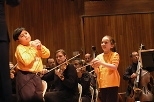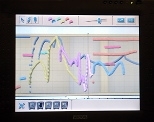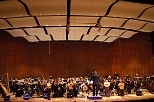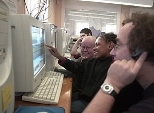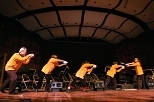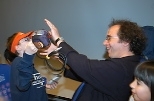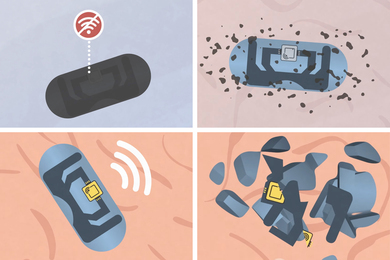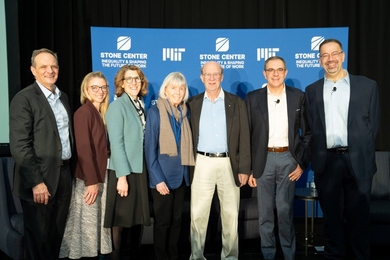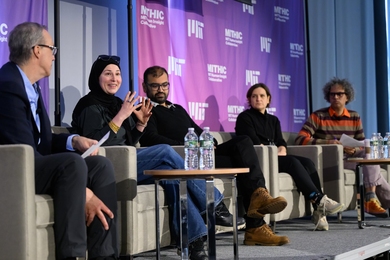Composer Tod Machover, conductor Gil Rose and musicians of the Boston Modern Orchestra Project (BMOP) joined Boston-area children to offer some wild and whimsical lessons in music-making as they performed Machover's Toy Symphony on Saturday, April 26.
The Kresge Auditorium event culminated three months of workshops with the children and intensive rehearsals with the Brookline-based PALS (Performing Artists at Lincoln School) chorus. The children played unique "hyperinstruments" developed by Machover, professor of music and media, and others at the Media Lab.
"Sparkler" and "Toy Symphony," Machover's own compositions, framed the hour-long event. "Sparkler," his overture, was the only piece played without children; it launched the composer's mission, a community adventure in following threads of sound through complex pieces.
"Sparkler" acknowledges the famous "three B's--Bach, Beethoven and Brahms," Machover explained. "The three B's in 'Sparkler' are Beethoven, the Beatles and Blobs."
With characteristic warmth, he invited the audience to listen "inside the music" for a "very well-known piece by Beethoven; 50 hidden Beatles songs; and Blobs--sounds electronically knocked around the room" thanks to six microphones and three electronic keyboards embedded among the instruments.
For clues on finding Blobs' musical trail, Machover urged the audience to watch BMOP conductor Gil Rose "very closely. When you see him do gestures like poking or chopping, you'll hear Blobs come to life."
"Nature Suite," composed by Jean-Pascal Beintus, introduced Music Shapers, the soft, fabric-covered grapefruits designed by Media Lab researchers. Shapers give children a tactile experience of timbre, contour and density--by squeezing the Shaper, they change the quality of sound. "Nature Suite," performed by the BMOP musicians and four children squeezing Shapers, portrayed autumn and winter, mixing sounds of rain, wind, hooting owls and croaking frogs with traditional instruments.
Toy Symphony had its own style, too; children wore long-sleeved orange T-shirts printed with a white Toy Symphony logo, black pants and black shoes. The adult musicians wore black. Machover wore a black suit and T-shirt.
"Gestures," composed by 12-year-old Natasha Sinha and Hugo Solis, a graduate student in media arts and sciences, was performed by six children squeezing Music Shapers and adults playing trumpets, trombones, violas and one double bass.
"Nerve," composed by Gil Weinberg, introduced Beatbugs, handheld percussive instruments shaped like beetles. Children press the stubby antennae to create and change rhythmic patterns. Beatbugs--which are programmed to store, play back and "swap" notes with other Beatbugs--appeared onstage to relate to one another like fireflies on a summer night: they lit up when they were in contact.
The Beatbug performers (six children and two professional percussionists) improvised duets, quartets and finally an octet that looked like a light-saber battle from "Star Wars."
"Composition for String Orchestra" showcased three pieces created by Boston-area children using Hyperscore, the principal composition tool of the Toy Symphony project. Hyperscore is an electronic sketchpad in which freehand drawings are translated into color-coded musical materials such as chords, melodies and other sounds. Hyperscore pieces composed on computers were transcribed to traditional notation for the BMOP musicians. One was called "Attack of the Headless Chickens."
Tracing threads of sound was easiest in this segment, thanks to a large screen displaying Hyperscore that hung above the BMOP musicians. Each phrase they played flickered on the screen, so individual musical elements--pastel lines and droplets the consistency of embroidery floss--appeared to "draw" the orchestra through each piece.
Machover's "Toy Symphony" brought the evening to a cheerful, expansive close. Featuring 20-year-old Irish violin star Cora Venus Luddy on hyperviolin and the PALS chorus, "Toy Symphony" included Beatbugs, Music Shapers and all the BMOP musicians.
Machover described "Toy Symphony" as "about all kinds of people playing all kind of music together" and gently warned the audience not to try making sense of the choral text.
"It's a language I made up," he said gleefully. Then, ever the music creator and teacher, he added, "Of course, my daughters' names, Hana and Noa, are in it. And a little something of the Beatles. You may want to listen for those hidden sounds."
A version of this article appeared in MIT Tech Talk on April 30, 2003.
